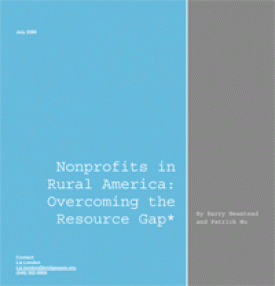Bridgespan Study Examines Rural Funding Challenges
Resource type: Research Report
The Bridgespan Group |
Rural nonprofit organisations in the United States that consistently attract funding offer three key lessons for others that are struggling, according to this case study commissioned by The Atlantic Philanthropies.
The National Indian Youth Leadership Project and the Bridgespan Group are Atlantic grantees.
Authors: Barry Newstead & Pat Wu
The issue of nonprofit funding is topical given the economic climate, but for rural nonprofits it is a chronic reality of life. In a recent study on the rural funding gap, the Bridgespan Group found that rural nonprofits lag behind their urban counterparts in terms of their share of federal government, private foundation, and corporate donations and as such they are less well positioned to help disadvantaged residents in their communities. Funded by a grant from the Atlantic Philanthropies, the study looked at the funding structure of rural nonprofits in two sample states – California and New Mexico to understand the gap. The report identified lessons learned from successful rural youth serving organizations including National Indian Youth Leadership Program (NIYLP) in New Mexico, Boys and Girls Club of Fresno, and the Human Response Network in Northern California’s Trinity County.
“This research is intended to look systematically at the financial aspects of rural nonprofit capacity,” said Nicole Gallant, Program Executive for Children and Youth. “While there are other important issues to consider for rural nonprofits, we believe the flow of money is a good place to start.”
“Despite undeniable funding challenges for rural nonprofits, our research also revealed that a small number of rural nonprofits are making headway,” said Bridgespan Partner Barry Newstead, who co-authored the study. “So while there is more work to be done to deeply understand how best to strengthen this sector, our preliminary research surfaces a handful of practices that rural nonprofits might find helpful, particularly in these tough times.”
Key findings from the study include:
- Rural nonprofits in California and New Mexico are proportionately smaller than their urban counterparts;
- Very few rural nonprofits manage to grow to greater than $1M leaving most at a size where they don’t have the resources needed to build a strong organization and serve the full needs of their community;
- For rural nonprofits in particular, closing the funding gap requires exceptional relationship building, and leaders who are intent on developing those relationships and networks;
- Focusing on quality rather than quantity of proposals, ensuring strong alignment between donor and program goals, and investing in grants that may further key relationships can lead to better results;
- Tailoring programs to meet the specific needs of rural communities is vital; it creates a unique value proposition for funders.
Underscoring the importance of relationship building, Executive Director of Northern California’s Human Response Network Jerry Cousins said that he has made a concerted effort to develop well trained staff who commit time to cultivating a network of government officials and foundations from the field while maintaining high quality service at home.
NIYLP of New Mexico has long pursued a strategy of being strategic in its grant writing efforts. They focus on key relationships, large or small. Additionally, in wrestling with how to serve a dispersed population of youth, many of whom reside in remote areas on reservation lands, they altered a program to focus on partnerships with schools in class and intensively on weekends and holidays rather than an after school format, which was not cost effective. This pleased a key funder by putting costs in better alignment with the funder’s per capita targets.
“The rural funding gap is real and presents challenges for both rural nonprofits and private foundations that care about tackling poverty. There are no silver bullets but the themes are a good reminder for leaders of the hard work required to expand the resources available for youth and families in need in rural communities,” said Bridgespan’s Newstead.
About The Bridgespan Group
Founded in 2000 and incubated at Bain & Company, the Bridgespan Group (bridgespan.org) is a 501(c)(3) nonprofit organization that helps nonprofit and philanthropic leaders to make strategic decisions and to build organizations that inspire and accelerate social change. At the heart of our mission is the belief that a strong and effective nonprofit sector can be a powerful force for change as well as a source of human inspiration.
We believe that results are driven by three levers: solid strategy; access to appropriately structured capital; and talent that begins with leaders and senior managers. We exist to apply the best relevant thinking and tools to strengthen these levers and to help organizations deliver on their missions. Our services include strategy consulting, executive search, and philanthropy advising.
The Bridgespan Group’s Bridgestar initiative seeks to help nonprofits attract, connect, and develop strong leadership teams to strengthen the overall performance of the sector.
